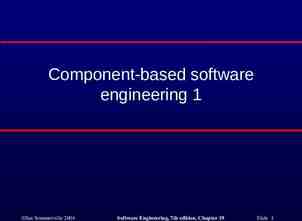Switching An Engineering Approach to Computer Networking
63 Slides283.50 KB

Switching An Engineering Approach to Computer Networking

What is it all about? How do we move traffic from one part of the network to another? Connect end-systems to switches, and switches to each other Data arriving to an input port of a switch have to be moved to one or more of the output ports

Types of switching elements Telephone switches Datagram routers switch samples switch datagrams ATM switches switch ATM cells

Classification Packet vs. circuit switches packets have headers and samples don’t Connectionless vs. connection oriented connection oriented switches need a call setup setup is handled in control plane by switch controller connectionless switches deal with self-contained datagrams Packet switch Circuit switch Connectionless (router) Internet router Connection-oriented (switching system) ATM switching system Telephone switching system

Other switching element functions Participate in routing algorithms Resolve contention for output trunks to build routing tables scheduling Admission control to guarantee resources to certain streams We’ll discuss these later Here we focus on pure data movement

Requirements Capacity of switch is the maximum rate at which it can move information, assuming all data paths are simultaneously active Primary goal: maximize capacity Circuit switch must reject call if can’t find a path for samples from input to output goal: minimize call blocking Packet switch must reject a packet if it can’t find a buffer to store it awaiting access to output trunk subject to cost and reliability constraints goal: minimize packet loss Don’t reorder packets

A generic switch

Outline Circuit switching Packet switching Switch generations Switch fabrics Buffer placement Multicast switches

Circuit switching Moving 8-bit samples from an input port to an output port Recall that samples have no headers Destination of sample depends on time at which it arrives at the switch actually, relative order within a frame We’ll first study something simpler than a switch: a multiplexor

Multiplexors and demultiplexors Most trunks time division multiplex voice samples At a central office, trunk is demultiplexed and distributed to active circuits Synchronous multiplexor N input lines Output runs N times as fast as input

More on multiplexing Demultiplexor one input line and N outputs that run N times slower samples are placed in output buffer in round robin order Neither multiplexor nor demultiplexor needs addressing information (why?) Can cascade multiplexors need a standard example: DS hierarchy in the US and Japan

Inverse multiplexing Takes a high bit-rate stream and scatters it across multiple trunks At the other end, combines multiple streams resequencing to accommodate variation in delays Allows high-speed virtual links using existing technology

A circuit switch A switch that can handle N calls has N logical inputs and N logical outputs N up to 200,000 In practice, input trunks are multiplexed example: DS3 trunk carries 672 simultaneous calls Multiplexed trunks carry frames set of samples Goal: extract samples from frame, and depending on position in frame, switch to output each incoming sample has to get to the right output line and the right slot in the output frame demultiplex, switch, multiplex

Call blocking Can’t find a path from input to output Internal blocking Output blocking slot in output frame exists, but no path no slot in output frame is available Output blocking is reduced in transit switches need to put a sample in one of several slots going to the desired next hop

Time division switching Key idea: when demultiplexing, position in frame determines output trunk Time division switching interchanges sample position within a frame: time slot interchange (TSI)

How large a TSI can we build? Limit is time taken to read and write to memory For 120,000 circuits need to read and write memory once every 125 microseconds each operation takes around 0.5 ns impossible with current technology Need to look to other techniques

Space division switching Each sample takes a different path thoguh the swithc, depending on its destination

Crossbar Simplest possible space-division switch Crosspoints can be turned on or off For multiplexed inputs, need a switching schedule (why?) Internally nonblocking but need N2 crosspoints time taken to set each crosspoint grows quadratically vulnerable to single faults (why?)

Multistage crossbar In a crossbar during each switching time only one crosspoint per row or column is active Can save crosspoints if a crosspoint can attach to more than one input line (why?) This is done in a multistage crossbar Need to rearrange connections every switching time

Multistage crossbar Can suffer internal blocking unless sufficient number of second-level stages Number of crosspoints N2 Finding a path from input to output requires a depth-first-search Scales better than crossbar, but still not too well 120,000 call switch needs 250 million crosspoints

Time-space switching Precede each input trunk in a crossbar with a TSI Delay samples so that they arrive at the right time for the space division switch’s schedule

Time-space-time (TST) switching Allowed to flip samples both on input and output trunk Gives more flexibility lowers call blocking probability

Outline Circuit switching Packet switching Switch generations Switch fabrics Buffer placement Multicast switches

Packet switching In a circuit switch, path of a sample is determined at time of connection establishment No need for a sample header--position in frame is enough In a packet switch, packets carry a destination field Need to look up destination port on-the-fly Datagram Cell lookup based on entire destination address lookup based on VCI Other than that, very similar

Repeaters, bridges, routers, and gateways Repeaters: at physical level Bridges: at datalink level (based on MAC addresses) (L2) Routers: at network level (L3) participate in routing protocols Application level gateways: at application level (L7) discover attached stations by listening treat entire network as a single hop e.g mail gateways and transcoders Gain functionality at the expense of forwarding speed for best performance, push functionality as low as possible

Port mappers Look up output port based on destination address Easy for VCI: just use a table Harder for datagrams: need to find longest prefix match e.g. packet with address 128.32.1.20 entries: (128.32.*, 3), (128.32.1.*, 4), (128.32.1.20, 2) A standard solution: trie

Tries Two ways to improve performance cache recently used addresses in a CAM move common entries up to a higher level (match longer strings)

Blocking in packet switches Can have both internal and output blocking Internal no path to output Output trunk unavailable Unlike a circuit switch, cannot predict if packets will block (why?) If packet is blocked, must either buffer or drop it

Dealing with blocking Overprovisioning Buffers at input or output Backpressure internal links much faster than inputs if switch fabric doesn’t have buffers, prevent packet from entering until path is available Parallel switch fabrics increases effective switching capacity

Outline Circuit switching Packet switching Switch generations Switch fabrics Buffer placement Multicast switches

Three generations of packet switches Different trade-offs between cost and performance Represent evolution in switching capacity, rather than in technology With same technology, a later generation switch achieves greater capacity, but at greater cost All three generations are represented in current products

First generation switch Most Ethernet switches and cheap packet routers Bottleneck can be CPU, host-adaptor or I/O bus, depending

Example First generation router built with 133 MHz Pentium Mean packet size 500 bytes Interrupt takes 10 microseconds, word access take 50 ns Per-packet processing time takes 200 instructions 1.504 µs Copy loop register - memory[read ptr] memory [write ptr] - register read ptr - read ptr 4 write ptr - write ptr 4 counter - counter -1 if (counter not 0) branch to top of loop 4 instructions 2 memory accesses 130.08 ns Copying packet takes 500/4 *130.08 16.26 µs; interrupt 10 µs Total time 27.764 µs speed is 144.1 Mbps Amortized interrupt cost balanced by routing protocol cost

Second generation switch Port mapping intelligence in line cards ATM switch guarantees hit in lookup cache Ipsilon IP switching assume underlying ATM network by default, assemble packets if detect a flow, ask upstream to send on a particular VCI, and install entry in port mapper implicit signaling

Third generation switches Bottleneck in second generation switch is the bus (or ring) Third generation switch provides parallel paths (fabric)

Third generation (contd.) Features self-routing fabric output buffer is a point of contention unless we arbitrate access to fabric potential for unlimited scaling, as long as we can resolve contention for output buffer

Outline Circuit switching Packet switching Switch generations Switch fabrics Buffer placement Multicast switches

Switch fabrics Transfer data from input to output, ignoring scheduling and buffering Usually consist of links and switching elements

Crossbar Simplest switch fabric think of it as 2N buses in parallel Used here for packet routing: crosspoint is left open long enough to transfer a packet from an input to an output For fixed-size packets and known arrival pattern, can compute schedule in advance Otherwise, need to compute a schedule on-the-fly (what does the schedule depend on?)

Buffered crossbar What happens if packets at two inputs both want to go to same output? Can defer one at an input buffer Or, buffer crosspoints

Broadcast Packets are tagged with output port # Each output matches tags Need to match N addresses in parallel at each output Useful only for small switches, or as a stage in a large switch

Switch fabric element Can build complicated fabrics from a simple element Routing rule: if 0, send packet to upper output, else to lower output If both packets to same output, buffer or drop

Features of fabrics built with switching elements NxN switch with bxb elements has log bN elements with elements per stage Fabric is self routing Recursive Can be synchronous or asynchronous Regular and suitable for VLSI implementation N / b

Banyan Simplest self-routing recursive fabric (why does it work?) What if two packets both want to go to the same output? output blocking

Blocking Can avoid with a buffered banyan switch Instead, can check if path is available before sending packet but this is too expensive hard to achieve zero loss even with buffers three-phase scheme send requests inform winners send packets Or, use several banyan fabrics in parallel intentionally misroute and tag one of a colliding pair divert tagged packets to a second banyan, and so on to k stages expensive can reorder packets output buffers have to run k times faster than input

Sorting Can avoid blocking by choosing order in which packets appear at input ports If we can present packets at inputs sorted by output remove duplicates remove gaps precede banyan with a perfect shuffle stage then no internal blocking For example, [X, 010, 010, X, 011, X, X, X] -(sort)- [010, 011, 011, X, X, X, X, X] -(remove dups)- [010, 011, X, X, X, X, X, X] -(shuffle)- [010, X, 011, X, X, X, X, X] Need sort, shuffle, and trap networks

Sorting Build sorters from merge networks Assume we can merge two sorted lists Sort pairwise, merge, recurse

Merging

Putting it together- Batcher Banyan What about trapped duplicates? recirculate to beginning or run output of trap to multiple banyans (dilation)

Effect of packet size on switching fabrics A major motivation for small fixed packet size in ATM is ease of building large parallel fabrics In general, smaller size more per-packet overhead, but more preemption points/sec Fixed size packets helps build synchronous switch At high speeds, overhead dominates! But we could fragment at entry and reassemble at exit Or build an asynchronous fabric Thus, variable size doesn’t hurt too much Maybe Internet routers can be almost as cost-effective as ATM switches

Outline Circuit switching Packet switching Switch generations Switch fabrics Buffer placement Multicast switches

Buffering All packet switches need buffers to match input rate to service rate or cause heavy packet loses Where should we place buffers? input in the fabric output shared

Input buffering (input queueing) No speedup in buffers or trunks (unlike output queued switch) Needs arbiter Problem: head of line blocking with randomly distributed packets, utilization at most 58.6% worse with hot spots

Dealing with HOL blocking Per-output queues at inputs Arbiter must choose one of the input ports for each output port How to select? Parallel Iterated Matching inputs tell arbiter which outputs they are interested in output selects one of the inputs some inputs may get more than one grant, others may get none if 1 grant, input picks one at random, and tells output losing inputs and outputs try again Used in DEC Autonet 2 switch

Output queueing Don’t suffer from head-of-line blocking But output buffers need to run much faster than trunk speed (why?) Can reduce some of the cost by using the knockout principle unlikely that all N inputs will have packets for the same output drop extra packets, fairly distributing losses among inputs

Shared memory Route only the header to output port Bottleneck is time taken to read and write multiported memory Doesn’t scale to large switches But can form an element in a multistage switch

Datapath: clever shared memory design Reduces read/write cost by doing wide reads and writes 1.2 Gbps switch for 50 parts cost

Buffered fabric Buffers in each switch element Pros Speed up is only as much as fan-in Hardware backpressure reduces buffer requirements Cons costly (unless using single-chip switches) scheduling is hard

Hybrid solutions Buffers at more than one point Becomes hard to analyze and manage But common in practice

Outline Circuit switching Packet switching Switch generations Switch fabrics Buffer placement Multicast switches

Multicasting Useful to do this in hardware Assume portmapper knows list of outputs Incoming packet must be copied to these output ports Two subproblems generating and distributing copes VCI translation for the copies

Generating and distributing copies Either implicit or explicit Implicit Explicit suitable for bus-based, ring-based, crossbar, or broadcast switches multiple outputs enabled after placing packet on shared bus used in Paris and Datapath switches need to copy a packet at switch elements use a copy network place # of copies in tag element copies to both outputs and decrements count on one of them collect copies at outputs Both schemes increase blocking probability

Header translation Normally, in-VCI to out-VCI translation can be done either at input or output With multicasting, translation easier at output port (why?) Use separate port mapping and translation tables Input maps a VCI to a set of output ports Output port swaps VCI Need to do two lookups per packet






